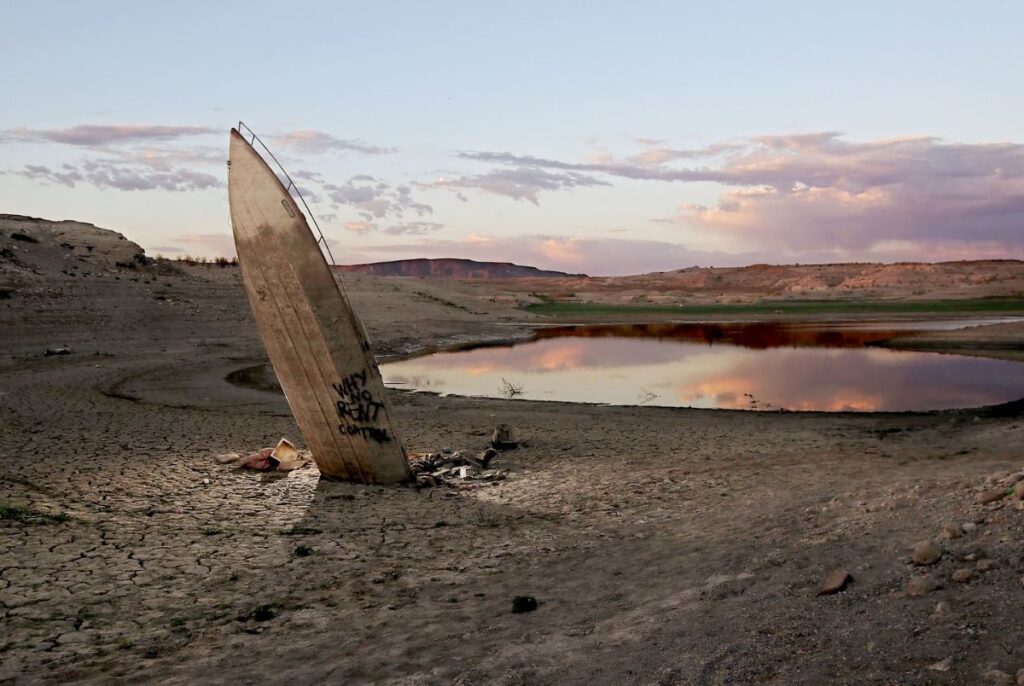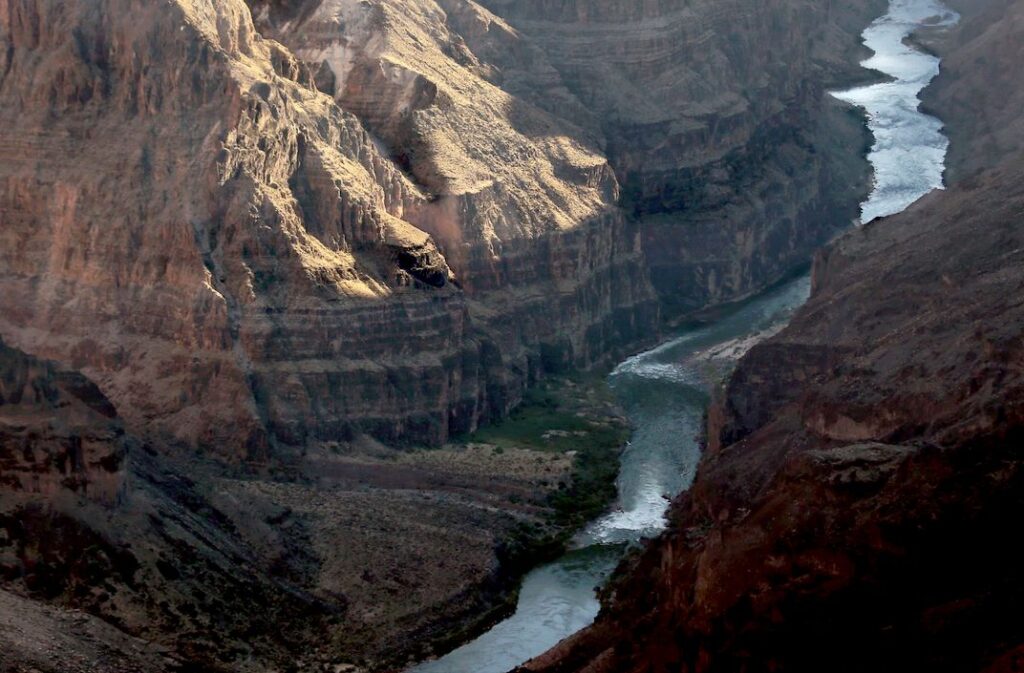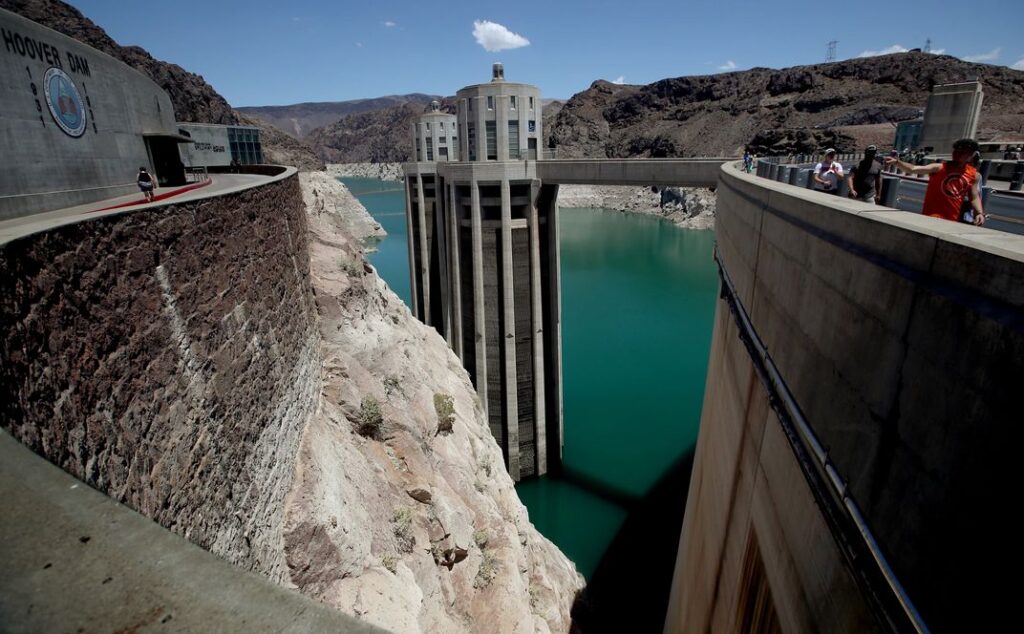Scientists sounded alarms about a coming Colorado River crisis. But warnings went unheeded
Years ago, scientists said climate change would bring a Colorado River crisis. Their warnings, which largely went unheeded, are now playing out.
Source of this article: The Los Angeles Times, July 17, 2022
The Colorado River is approaching a breaking point, its reservoirs depleted and Western states under pressure to drastically cut water use.
It’s a crisis that scientists have long warned was coming. Years before the current shortage, scientists repeatedly alerted public officials who manage water supplies that the chronic overuse of the river combined with the effects of climate change would likely drain the Colorado’s reservoirs to dangerously low levels.

A boat juts from the shoreline of Lake Mead, exposed as the water has receded to the lowest levels since the reservoir was filled in the 1930s.
But these warnings by various researchers — though discussed and considered by water managers — went largely unheeded.
Now, many of the scientists’ dire predictions are coming to pass, with Lake Mead and Lake Powell nearly three-fourths empty and their water levels continuing to fall. Some researchers say the seven states that depend on the river would have been better prepared had they acted years ago.
“If I’ve learned anything recently, it’s that humans are really reluctant to give things up to prevent a catastrophe,” said Brad Udall, a water and climate scientist at Colorado State University. “They’re willing to hang on to the very end and risk a calamity.”
He said it’s just like humanity’s lack of progress in addressing climate change despite decades of warnings by scientists.
If larger cuts in water use were made sooner, Udall said, the necessary reductions could have been phased in and would have been much easier.
Peter Gleick, a water and climate scientist and co-founder of the Pacific Institute, said the collective failure to heed scientists’ repeated warnings is “directly responsible for how bad conditions are today.”
“If we had cut water use in the Colorado River over the last two decades to what we now understand to be the actual levels of water availability, there would be more water in the reservoirs today,” Gleick said. “The crisis wouldn’t be nearly as bad.”
In a 1993 study for the federal government, Gleick and coauthor Linda Nash examined the threat climate change posed for the river and warned that the water supply would be very sensitive to rising temperatures.
“Under conditions of long-term flow reductions and current operating rules, these reservoirs are drawn almost completely dry,” they wrote. “Current approaches to water management in the basin will have to be modified.”
In 2000, board members of the Metropolitan Water District who were concerned about climate change invited scientists including Gleick to speak at a workshop. The scientists advised them to start preparing for consequences including less Sierra snow and possible decades of drought.
Gleick said a common refrain from many water managers in the 1980s and ’90s, when told about risks based on climate projections, was to respond that once they had a more definitive picture of effects on water resources, they could deal with it.
Even later, as the projections got more definitive and “alarm bells got louder,” Gleick said, political barriers hindered changes in the entrenched system of how the river’s water is divided and managed, a system established starting with the 1922 Colorado River Compact. Action was stymied, he said, by those “who either didn’t want to believe the science or had something to lose if we changed our policies.”
Gleick said there is a parallel in how fossil fuel interests have long fought the sorts of changes necessary to address global warming.
In the Colorado River Basin, Gleick said, the vested interests that have hindered new approaches for dealing with the water shortfall include some in agriculture who benefit from generations-old water rights, water managers with a “find more and more water” mentality, and politicians who’ve fought to defend old state apportionments.
In the 2000s, as drought ravaged the watershed, a growing body of scientific research showed that higher temperatures would substantially shrink the flow of the river, which supplies farmlands and cities from the Rocky Mountains to Southern California and northern Mexico.
In a 2004 study, scientists at the University of Washington projected major declines in runoff and river flow with warmer temperatures.
In other research in 2007, scientists Martin Hoerling and Jon Eischeid wrote that climate simulations showed an an increase in drought severity would occur “in lockstep” with global warming, projecting a 25% reduction in flow from 2006 to 2030, and a 45% decrease by midcentury.
When federal officials released a report in 2007 on new river management rules, their estimates of future risks were rosier, showing minimal odds of reservoirs reaching low levels. The report cited studies predicting declines in river flow with climate change, saying that while those projections “are of great interest, additional research is both needed and warranted to quantify the uncertainty of these estimates.”
In a 2008 study, scientists Tim Barnett and David Pierce of the Scripps Institution of Oceanography wrote that if climate models were correct, the Colorado River would “continue to lose water in the future,” with its flow likely declining 10% to 30% over the next 30 to 50 years. Those estimates turned out to match, if conservatively, the 20% decline in flow that has occurred since 2000.
Barnett and Pierce estimated that if current allocations stayed the same, there was a 50% chance the usable water supply in Lake Mead and Lake Powell, the country’s two largest reservoirs, would be gone by 2021. They titled their study “When Will Lake Mead Go Dry?”
They said that annually the region was taking out about 1 million acre-feet of water more than the river was providing, which they warned was “simply not sustainable.” Barnett and Pierce wrote that time was short to decide how to use a reduced water supply, and the alternative would be a “major societal and economic disruption in the desert southwest.”
Discussing the research, Barnett said: “You have to wonder if the civilization we’ve built in the desert Southwest is sustainable in the future.”
The scientists’ findings, however, were discounted at the time by some water managers. Terry Fulp, regional director for the federal Bureau of Reclamation, said he disagreed with the study’s assumption that climate models were sensitive or refined enough to project regional effects, and the agency’s own studies didn’t project such severe declines.
Some Southern California water officials said people shouldn’t panic over the report, pointing to ongoing water-saving efforts and the past winter’s above-average snowpack. Roger Patterson, an assistant manager of the Metropolitan Water District, was quoted as saying that back-to-back winters like that could largely refill the reservoirs.

The Colorado River, vital to seven states, as seen from the Toroweap Overlook on the North Rim of the Grand Canyon.
In another study in 2009, Barnett and Pierce found that if human-caused climate change continued to make the Southwest drier as projected, the reduced river flow would mean significant shortages. Pierce said shortfalls could be avoided “if the river’s users agree on a way to reduce their average water use.”
But that didn’t happen, at least not on the scale the researchers said was necessary.
“The scientists have been raising the warning flag for quite a while now,” said Jennifer Pitt of the National Audubon Society.
Pitt said for years she and other conservationists urged water managers to look more at the climate models. And although officials gradually incorporated more climate science in their projections, she said, the institutions that manage the river clearly didn’t embrace the red flags soon enough.
A 2012 study by the Bureau of Reclamation discussed estimates of reduced water supplies due to climate change, but Pitt said the severity of the projections was muted in the report’s summary.
Even as the reservoirs dropped, she said, there were other reasons why representatives of states and water districts resisted change.
“Each state and each water user has an inclination to fight to defend their access to water,” Pitt said, and this drive has weighed against “the need to defend the reliability of the entire system.”
The Colorado River has long been overallocated, with so much water diverted that its delta in Mexico dried up decades ago, leaving only small remnants of its once-vast wetlands.
In studies during the last decade, scientists have homed in on what climate models indicate about the river’s future, finding that roughly half the decline in flow has been due to warmer temperatures; that climate change is driving the “aridification” of the Southwest; that warming could take away more than one-fourth of the average flow by 2050; and that for each additional 1 degree Celsius (1.8 degrees Fahrenheit), the river’s flow is likely to decrease about 9%.
As the West endured more hot and dry years, the few wet winters failed to produce the sort of rebound that water managers had hoped for. As water kept flowing to growing cities and farmlands producing hay, lettuce and other crops, the reservoirs continued to drop.
Facing shortages, state officials in 2019 signed a set of agreements laying out plans for sharing in water reductions. When that wasn’t enough, they signed another deal last year.
But with Lake Mead and Lake Powell now just 27% full and declining toward new lows, the federal government has stepped in and ordered the seven states to come up with plans to cut water use by 2 million to 4 million acre-feet, the equivalent of roughly 15% to 30% of total annual diversions in the U.S. and Mexico.
Even long before scientists began studying the effects of rising temperatures on the river, various people raised concerns that there wouldn’t be sufficient water — among them John Wesley Powell, leader of the historic 1869 expedition through the Grand Canyon; scientist Eugene Clyde LaRue, whose warnings about insufficient water went unheeded during negotiations that led to the 1922 Colorado River Compact; and the writer Wallace Stegner, who warned in 1985 that the West was growing “beyond our limits” and that “There is just not enough water.”
Leaders of tribes have also spoken out against overexploitation of the river while pushing for years to have a bigger say in decisions about water management.
Some environmental activists have pointed out that in 1954 California water lawyer Northcutt Ely testified in Congress to oppose the construction of Glen Canyon Dam and another proposed dam, saying they were unnecessary, would lead to more losses from evaporation and increase the “overdraft” of the water supply.
John Weisheit, co-founder of the group Living Rivers, said Ely’s overarching goal was watershed sustainability. The concerns Ely raised nearly seven decades ago, he said, have only been compounded by climate change.
Living Rivers and two other groups filed a lawsuit in 2019 to challenge the federal government’s approach to managing Lake Powell, arguing that officials didn’t sufficiently consider climate change. They demanded the government consider the alternative of decommissioning Glen Canyon Dam.
Weisheit recalled telling federal officials at a public meeting in 2005 that the reservoirs were going to go empty, “and they laughed at me.”
Weisheit said water managers knew how bad the situation was years ago but have failed to rein in water demands to match the limited supply.
Udall said he has been frustrated that federal agencies continue to use 30 years as a baseline “climate normal,” because data from the late 20th century, which was cooler and wetter, “blinds us to the period we’re in right now.”
Federal officials have been using what they call “stress test” hydrology in their projections in recent years, leaving out earlier 20th century records while considering data going back to 1988. But Udall said this approach has continued to yield some projections that are too rosy, an issue that he said government specialists appear to be working to address.
Udall said he has looked over charts showing the reservoirs’ declines over the last 23 years and has wondered at what point “should we have been smarter?” That point, he said, was about a decade ago.
“We’re out of time,” he said. The solutions now will have to be “harsh and drastic.”
Looking back at the 2019 deal, the years of negotiations culminated in an agreement that reflected what was politically possible at the time, said John Entsminger, general manager of the Southern Nevada Water Authority.
“No one was willing to take bigger cuts then,” Entsminger said.
Entsminger said that in 2014, when he started leading the agency, he and his staff were focused on climate projections and the risks of low reservoir levels. That was why, in addition to prioritizing conservation, the agency spent $522 million building a new low-level pumping plant and intake at Lake Mead, which would allow Las Vegas to keep accessing water if the reservoir dropped to “dead pool,” a level at which water would no longer pass through Hoover Dam.
In 2015, when the water authority endorsed the project, Entsminger said he and others hoped they would never have to turn on the pumping plant. But they switched it on this year, and now Las Vegas is relying on the deeper intake.
Entsminger said many water managers who came before him had seen full reservoirs in the 1980s and operated under the assumption that a couple of snowy winters could bring a rebound. In hindsight, he said, “clearly, we should have had bigger cuts sooner.”
Now every water supplier needs to consider how to use less, he said.
“This is a tragedy of the commons situation,” he said. “If we don’t all pitch in and make corrections, Lake Mead and Lake Powell could get to dead pool.”




0 Comments